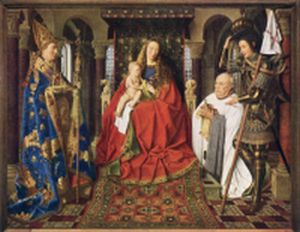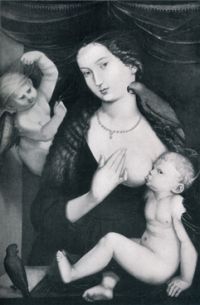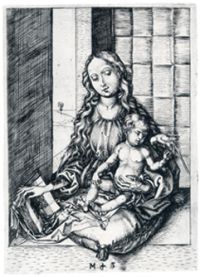Parrot in Marian Art
Parrot in Marian Art
– Father Johann G. Roten, S.M.
Q: The Parrot with Our Lady?
A: In paintings by Van Eyck, Baldung and Schongauer we sometimes detect the presence of one or several parrots. Van Eyck’s Madonna holds a beautiful green parrot in her hand, Baldung shows the nursing mother with two parrots (Bruges, 1436) one of these sitting on her left shoulder (Nürnberg 1527/1528). Noted is Martin Schongauer’s etching, Our Lady with a Parrot (~1470/75). (Gesneri Redivivi, aucti et emendati, Tomus II, Vollkommenes Vogelbuch, 1669, 88f.)
 Jan van Eyck, Madonna with the Canon van der Paele; Bruges, Groeninge Museum.
Jan van Eyck, Madonna with the Canon van der Paele; Bruges, Groeninge Museum.
As is well-known, flowers as well as animals frequently convey a symbolic meaning to religious figures and scenes. Thus, in the well known Defensorium inviolatae virginitatis beatae Mariae the parrot symbolizes the virginal motherhood of Mary. Why is that? Already in antiquity the parrot was considered a miracle of nature because of his uncanny ability to imitate and reproduce human speech. A number of Roman literary sources, among them Pliny (Nat. Hist. X, LVIII) and Martial (Epigr. 14. 73, 2) see in the parrot the herald of emperors. He greets the emperor with, Ave Caesar, in Martial’s words: “Psittacus a vobis aliorum nomina discam; / Hoc didici per me dicere: Caesar Have.” The Defensorium mentions Isidor of Sevilla’s Etymologies, (XII, 7, 92. PL82, 462) as reference of the antique writers and their symbolic interpretation of the parrot. In doing so, it develops its own significance: “Psittacus a natura si ‘Ave’ dicere valet, quare virgo per ‘Ave’ non generaret?” The virgin conceives in consequence of the angel’s greeting (Ave) and message-- a miraculous conception! Similarly and in unexplained fashion, the parrot proffers his Ave without having heard or learned it. This parallelism may not be sufficient to fully identify the parrot as a typical and exclusive Marian symbol. There are other and different symbolic meanings connected with this bird. Some authors see in the speaking parrot a symbol of the Word. His presence in Marian paintings could thus be read as life-giving power of God’s Word (see for ex. C. Purtle, The Marian Painting of Jan van Eyck, 1982, 91 f). Saint Albert the Great relates the parrot--living in regions without rain--to the fleece of Gideon and so to Mary’s inviolate virginity. Marian emblems sometimes show the parrot perched on the highest and thin branch of a tree and so out of reach of the menacing serpent: again a symbol of Mary’s exemption of original sin. (Gesheri Redivivi, See Marian Lexikon, 5/84)
 Maria mit dem Kinde und Papageien.
Maria mit dem Kinde und Papageien.
Nurnberg, Germanisches Nationalmuseum
 Martin Schongauer, Vierge a l'Enfant au perroquet, gravure
Martin Schongauer, Vierge a l'Enfant au perroquet, gravure
All About Mary includes a variety of content, much of which reflects the expertise, interpretations and opinions of the individual authors and not necessarily of the Marian Library or the University of Dayton. Please share feedback or suggestions with marianlibrary@udayton.edu.
